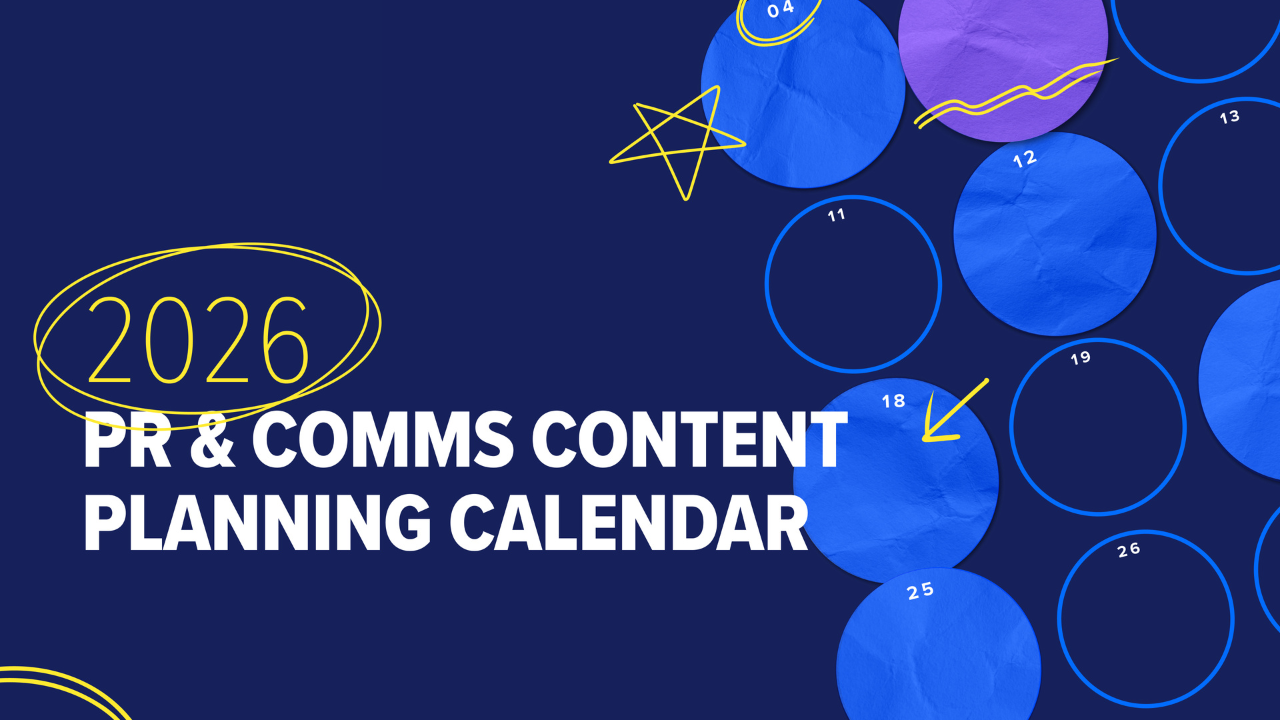Cision’s 2025 State of the Media Report gathers responses from over 3,000 journalists around the world and reveals fascinating insights for public relations professionals.
Some of the biggest findings of this year’s report revolve around ways to improve working relationships between the media and public relations professionals. Thanks to the candid feedback of the journalists who contributed to the report, we’ve identified seven tips for building better relations with media professionals.
Building Better Relations with Media Professionals
As a PR professional, building effective media relations can help you get more coverage for the brand you represent, but building those relationships takes time and effort, and even understanding where to begin isn’t always clear. That’s where the 2025 State of the Media Report comes in, providing the inside scoop on what PR pros can do to go from a random email address in a journalist’s inbox to a trusted contact. Follow these tips, and you’ll be on the right path.
1. Connect With Journalists on Their Terms
Imagine what it would be like to receive over 50 pitches per week. Where would you begin? That's what it's like for most journalists, and you can imagine how much time it takes to go through them.
Many pitches come from PR professionals that journalists don’t know (or don’t know well), presenting you with an opportunity. If you can build a relationship with journalists, they’ll recognize your name when you get in touch and are more likely to check your pitch. Start this process by building familiarity with journalists.
When we asked journalists directly how PR pros can take that first step in building relationships with them, 85% of journalists say that an email introducing yourself and why you want to connect is the way to go – making it the top answer by far. Other popular options include pitching a relevant story or idea as part of that introduction (38%) and inviting them to an industry event (33%).
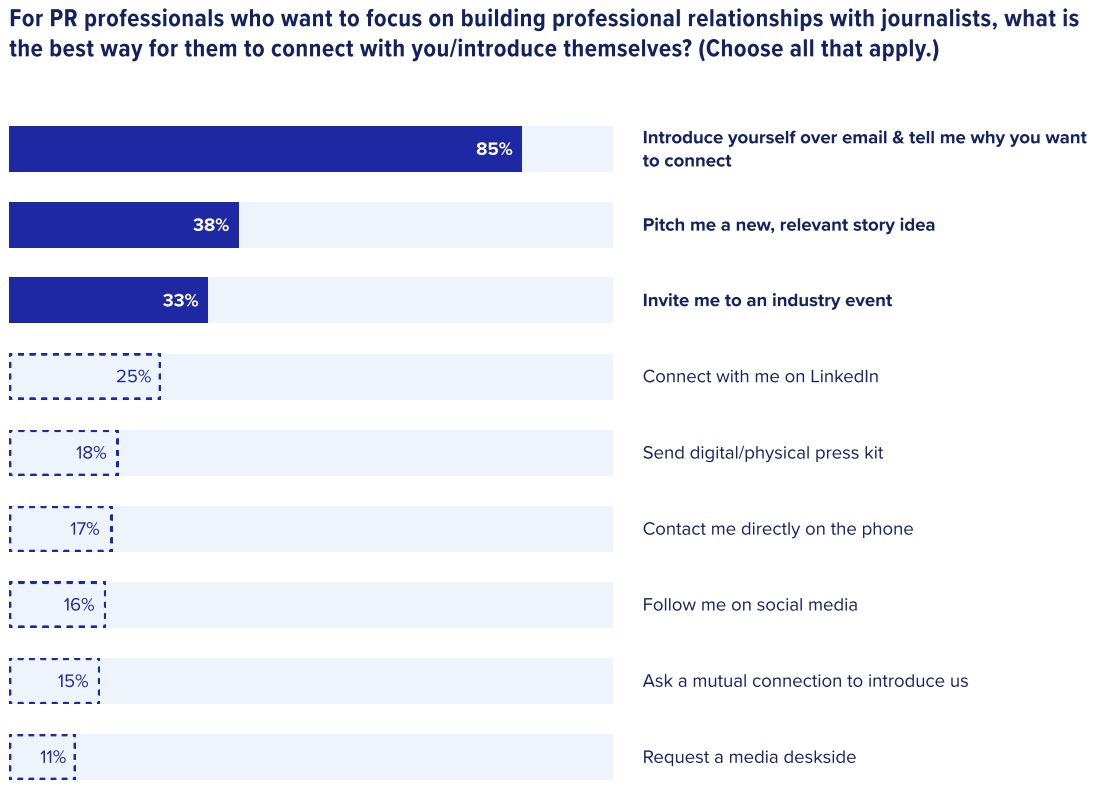
As the chart above indicates, there are a variety of ways journalists recommend connecting – and the less conventional ways may be more likely to get their attention. When we asked journalists to tell us in their own words why connecting with them is important, we received a range of answers, such as:
- “They pitch stories that we can localize.”
- “Knowledge of the industry we cover. Knowing [of] what they pitch.”
- “The best PR folks are the ones who add context and value outside of their immediate pitching needs, and who actually want to build a working relationship, not a transactional one.”
- “They often have greater resources than reporters and when they're compassionate and principled this can help create better coverage more quickly.”
- “Unique story angles are key. I'm not interested in ‘content.’ If the story isn't interesting to the PR professional, it won't be interesting to my readers, either.”
2. Use Social Media to Your Advantage
Social media can also be a great avenue for connecting with journalists, building a rapport, and getting to know them better.
We saw in the previous section that 25% of journalists advise PR pros to connect with them on LinkedIn and 16% suggest following them on social media. This matters because 96% of journalists are using social media for work, from sharing their content to finding information.
The majority of journalists (59%) say they use LinkedIn most often for professional purposes, but Facebook (53%) and Instagram (51%) are also popular choices for them, so start there to identify journalists you want to follow and connect with; however, don’t discount smaller platforms where the audiences may be smaller – they're also likely to be more engaged.
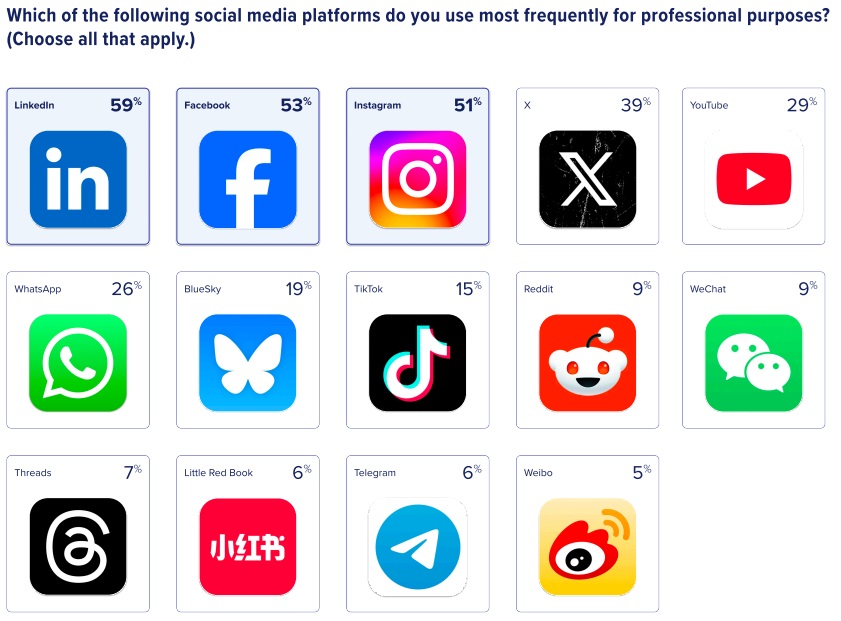
Knowing where to find journalists’ social profiles is one thing, but it’s also important to understand how they use the platforms. Sixty-four percent of journalists said they used social media to publish and promote content, 55% said they used social platforms to interact with their audience, and 51% for crowdsourcing information for stories.
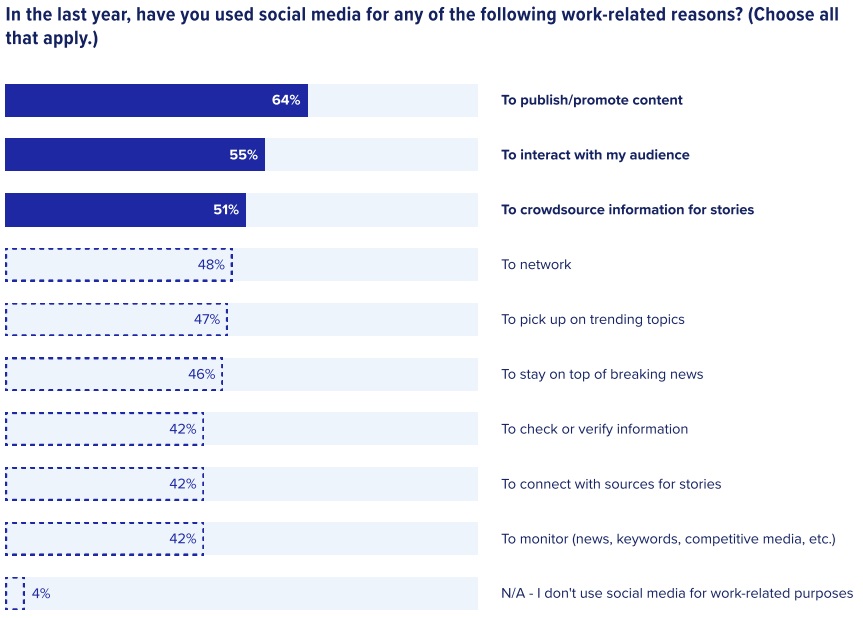
Social media plays a pivotal role in journalists’ lives, and you can learn a lot about them, their audiences, and the kind of content they cover by following them and engaging with them. All of these elements will help you better understand what journalists are looking for, enabling you to craft more personalized outreach and content that is relevant to their needs when it’s time to reach out with a pitch – or simply a reason to connect.
3. Mind Their Challenges and Frustrations
Building better relations with media professionals begins with understanding their challenges and frustrations. You’ll create a better platform to develop a relationship by being easy to work with and not adding to their workloads or stress levels. With that in mind, we asked journalists about the PR behaviors that test their patience the most.
Spamming journalists with pitches that don’t relate to their beat or audience is the number one behavior you want to avoid - 78% of the journalists we surveyed say they'll block a PR professional who uses this tactic. Other challenges journalists face, that may result in them blocking PR pros, are pitches that sound like marketing brochures (58%), inaccurate or unsourced information by 56%, and repeatedly following up by 52%.
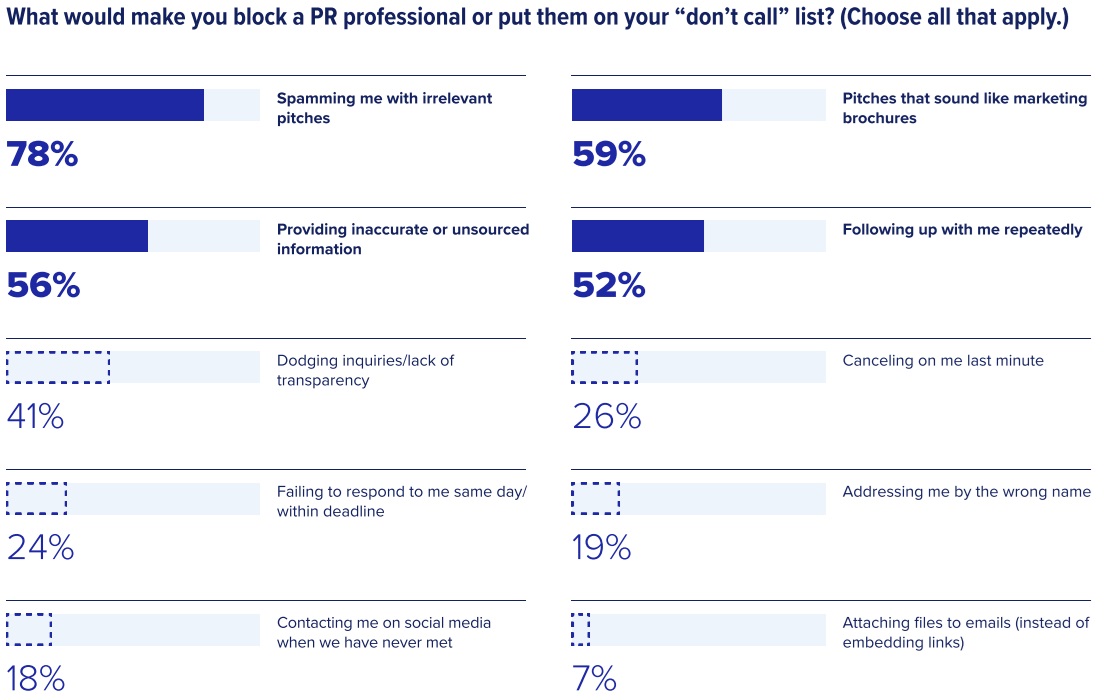
In short: Avoid pestering journalists to the point they block further communications and pitches from you – it’s a surefire way to burn bridges and end a relationship before it can even start. Take time to understand what journalists want – and what they don’t want – and your outreach will be that much more meaningful. By putting this forethought into your interactions, you’ll establish yourself as a reliable resource that journalists will want to work with again and again.
4. Focus on Relevance
The days of firing off your pitches to every media outlet you can find are over. Journalists don’t like being spammed with irrelevant pitches and having their time wasted. While this approach might seem harmless, as we saw above, journalists have no tolerance for it. Thus, it hampers your chances of building a relationship with journalists and working with them in the future.
Pitches can be a great way to build relationships with journalists (in fact, 38% said relevant pitches are a good way to connect with them), but they must be relevant. By understanding what journalists are looking for, you’ll show you’ve done your research and are trying to help them, which they will appreciate and remember.
More evidence that relevance is critical: 86% of journalists said the biggest reason they reject a pitch is that it isn’t relevant to their audience or beat. (Pitches that are too promotional, lack substance, or don’t have a compelling angle are also likely to immediately be dismissed.)
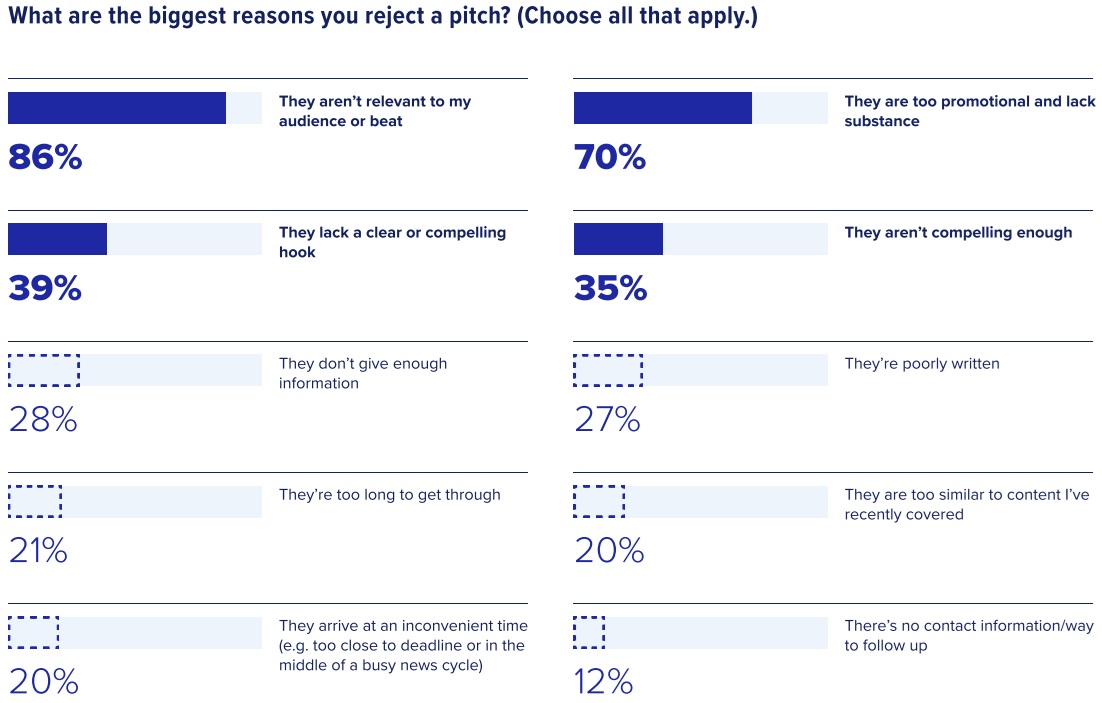
If you can do one thing to immediately gain good will with journalists, it’s taking the time to identify and customize your pitch for journalists specific to your industry or niche. Also consider brushing up on your pitching skills, making sure journalists have everything they want when you send a pitch.
5. Make Yourself Invaluable
Our State of the Media Report highlights exactly what journalists value in PR professionals, identifying the best ways to help them and solve their challenges. While 43% of journalists say PR pros provide value because of their relevant story ideas, and 39% through access to exclusive news or content, there are other ways to add value. Sixty-nine percent of journalists said PR professionals provide value by connecting them with relevant sources, while 58% said the value came from access to key people or places.
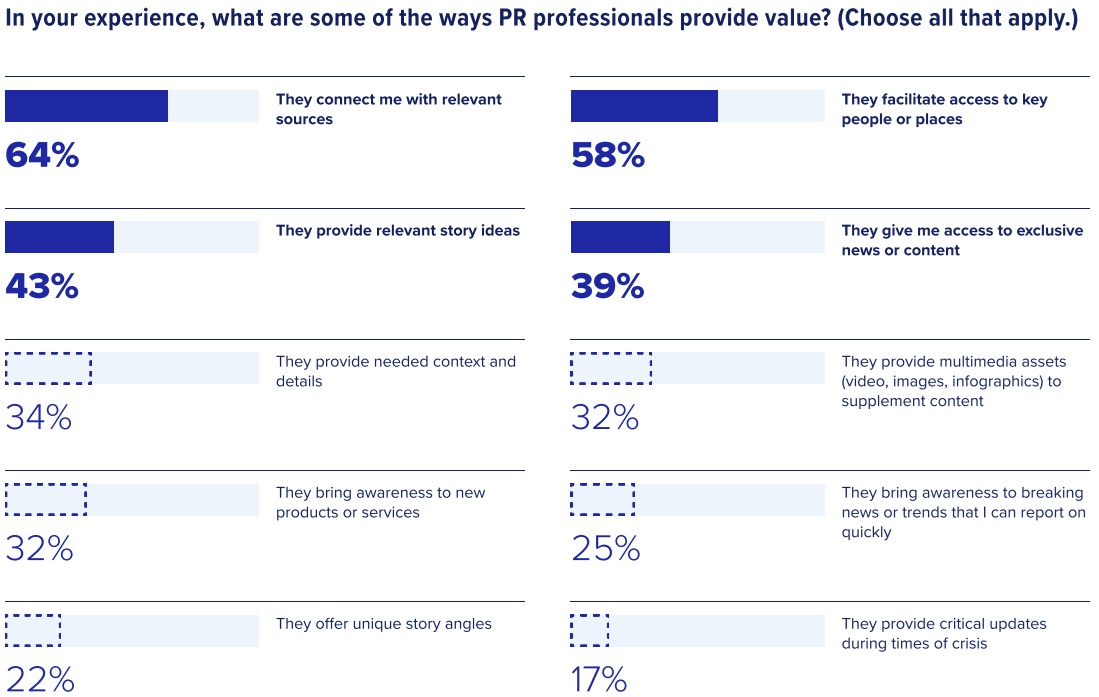
Think about the types of resources or information journalists request when they follow up on a pitch – from multimedia that adds context to a story or data to back up claims, to executive interviews or behind the scenes access.
Changing your approach from what journalists can do for you to what you can do for journalists opens a plethora of opportunities.
By anticipating journalists’ needs and proactively providing them with key resources that matter to their story – inside information, access to sources, multimedia assets – you'll set yourself apart as a reliable partner.
6. Give Journalists What They Want
Even though there are other ways to provide value to journalists, as seen above, providing ideas and specific content can also be a great way to earn their trust and partnerships. The more journalists you connect with, the more you’ll understand what they need on an individual level, but in the meantime, data from the State of the Media Report can help eliminate the guesswork of what journalists want from you.
Seventy-two percent of journalists want news announcements and press releases from PR professionals, and this type of content has consistently been the top answer in previous reports. Exclusive stories (57%) and original research reports (55%) are also very popular types of content media outlets are interested in.
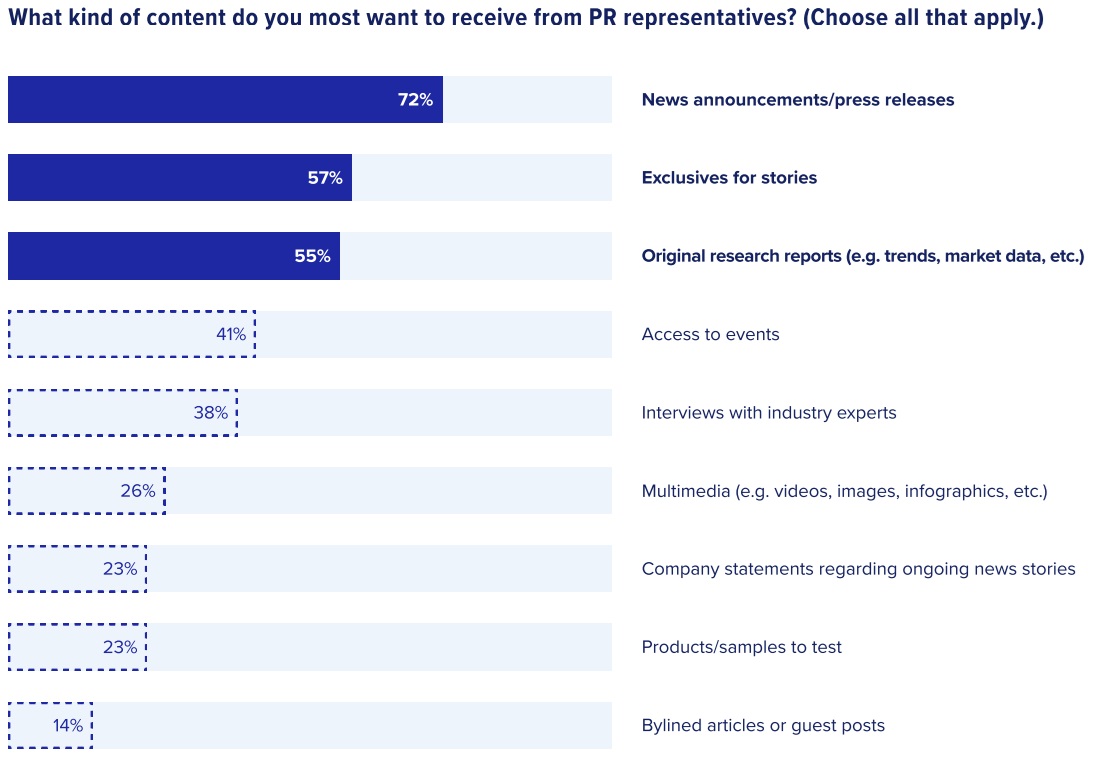
Keep in mind that most journalists are using multimedia in their content now – and in the last year, 84% used multimedia that PR professionals provided, which is more evidence of how PR professionals can provide value. When it comes to the type of multimedia journalists used most, images was the number one choice by far (70% of journalists used it). Data visualizations and infographics (30%), with videos and web polls or surveys (both 25%) were also in the top types of PR-provided multimedia journalists used.
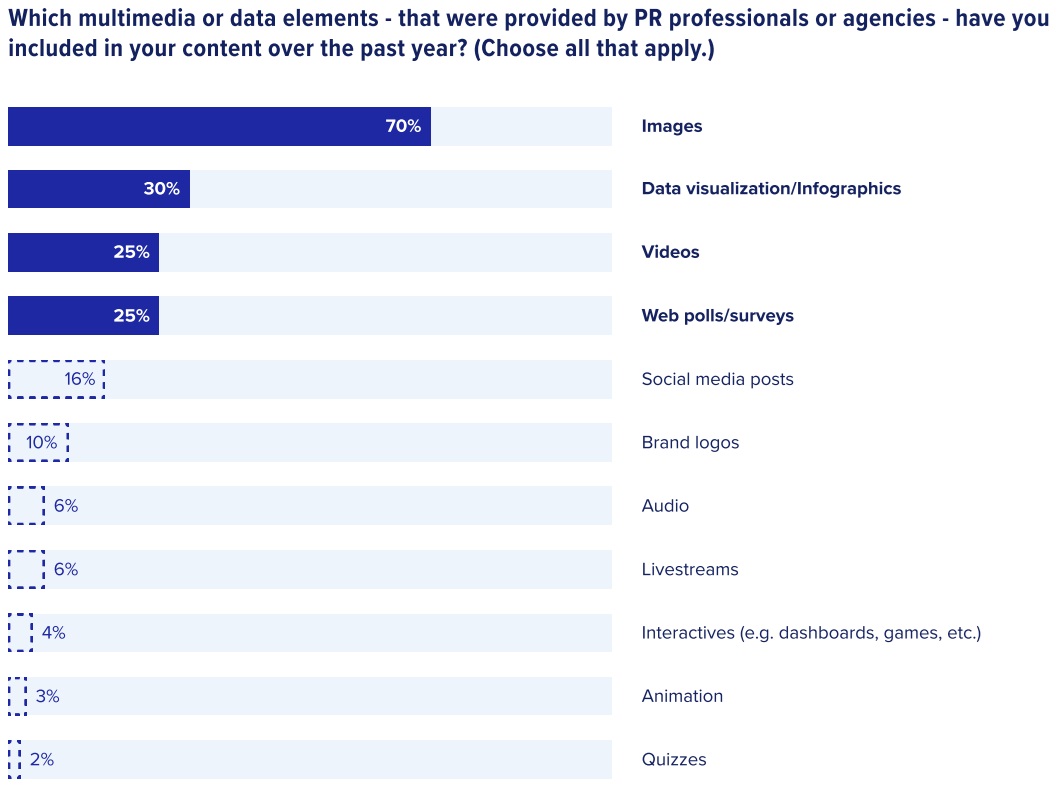
Giving journalists the content they want is a great way to improve PR and media relations. They know what their audiences want and how their content is consumed. Providing the type of content journalists want, including relevant multimedia, means the journalist has less work to do and will help cement your value to them.
7. Use Data to Establish Trust
One of the biggest challenges journalists say they face today is battling misinformation and accusations of “fake news.” PR professionals can help journalists overcome this challenge by providing verified data and being transparent about where it comes from, which builds trust between you and journalists. If journalists trust you, they are more likely to not only want to work with you again but even proactively approach you for future stories.
Data is so important to journalists, they explicitly ask for it: When asked what makes an ideal pitch (aside from it being relevant to their audience), the number one answer (cited by 54% of respondents to our report) was “compelling data or statistics.” Data visualizations or infographics were also among the top answers (cited by 30% of journalists) further underscoring the importance and value of data for members of the media. Additionally, when asked about the content journalists want most from PR professionals, more than half (55%) cited original research – the most popular answers after press releases and story exclusives.
As these findings illustrate, providing data can go a long way in first getting the attention of journalists and in building that trust that is so critical to any professional partnership.
The Importance of Media Relations
Building effective media relations takes a lot of investment and understanding. Journalists are busier than ever – just like yourself and other PR pros – but the benefits to strong relationships include more coverage for your brand and being a trusted resource whom journalists will want to work with again and again.
Building better relations with media professionals also takes time, but as findings from the 2025 State of the Media Report indicate, if you treat them with respect, value their time, and show them how you can make their lives easier, you’ll have a better chance of creating long-lasting collaborations that benefit both sides down the line.
For a deeper dive into what journalists want and need from PR professionals – and to see how answers vary across the world – read the full 2025 State of the Media Report.
Find out how CisionOne’s award-winning media outreach platform can help improve your PR and media relations by speaking to an expert.
Most Recent Posts
Cision Resources
-
E-books and Guides
Comprehensive how-to guides on strategy and tactics
-
Case Studies
What are other brands doing – and how can we learn from them?
About Dave McCreery
Dave is the Senior Content Manager at Cision specializing in SEO-driven content strategies. He has over 10 years of content creation experience and proven success crafting stories that engage, educate, and entertain audiences across different markets and industries.
Learn More. Do More. demo new
PR Tips, Case Studies, and Product Updates

[On-Demand Webinar] The Next Generation of Media Intelligence: From Gorkana to CisionOne
Explore CisionOne, a revolutionary media intelligence platform, and the evolution of Gorkana. Learn key features and strategies from Luke Williams, CisionOne Product Marketing Manager. Elevate your media outreach to new heights!

